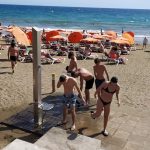The accident that occurred a few days ago in the AP-7 tunnel in Pilar de la Horadada, in which a truck caught fire and killed its driver, has damaged the infrastructure to the point where it will be closed in the Alicante-Cartagena direction for at least two months, reaching the peak of the summer season.
An inspection found that the northern half of the tube’s lighting and communications circuits and the two fans closest to the fire are damaged and need to be evaluated by the manufacturer.
In addition, the protective elements, trays, video surveillance circuit, and half of the inside cameras were damaged. The dealership is installing outdoor spotlights to allow work to be done inside, beginning with scrubbing the walls using pressurised water.
All of this means that traffic cannot be restored in the impacted area for at least the next two months. Until then, traffic will be diverted to the N-332, which runs parallel for approximately 4 kilometres near the town of Pilar de la Horadada. As a result of the road closure, there are considerable traffic bottlenecks on this segment, which is a normal route with one lane in each direction and multiple roundabouts. This issue will deteriorate when the summer season begins.
The Ministry of Transport and Sustainable Mobility intends to complete the essential repairs as well as the ongoing energy efficiency measures. However, to avoid more disruption for passengers, the upcoming work on the Alicante-bound tube will be postponed until at least September.
Although the infrastructure is the responsibility of the concessionaire Ausur, which manages the most expensive sections of motorway in Spain between La Zenia and Los Montesinos – while the section between Cartagena and Orihuela Costa and Los Montesinos-Crevillent that this concessionaire executed in exchange is free -, the funds being used for the work are Next Generation, European public funds, and the ministry – not the company – has processed the entire
This 800-meter-long tunnel, with an average daily traffic of 19,000 vehicles, opened in 1999 with the construction of the Ausur motorway, and is built and operated until 2048 by a private concessionaire led by large Murcian enterprises. It is free of charge in this part.
The Ministry had intended to begin a phase of work on Monday, May 25th, in the opposite lane where the accident happened, Cartagena-Alicante, which would require a closure, but after publicising the work only two hours after the tragedy, it eventually suspended the intervention.
The works are part of the Ministry’s €3.5 million project to modernise lighting and security systems. The investment will include the renovation of the power supply, emergency lighting, evacuation signage, emergency stations, public address systems, a fire hydrant network, ventilation systems, the installation of new automatic fire detection cameras, traffic control systems, and exterior tunnel closure barriers, among other projects.
The tunnel’s lighting system will also be modified to improve the facility’s energy efficiency by introducing an intelligent control and regulation mechanism. It will be necessary to replace the current VSAP luminaire technology with LED equipment that can be dimmed point by point.
The sophisticated lighting regulation and control system will enable continuous lighting regulation of individual units based on outside brightness and tunnel occupancy levels.
All of this has been postponed until September following the disaster last Friday, when a truck overturned within the AP-7 tunnel at Pilar de la Horadada at kilometre 272, travelling towards Cartagena. One of the wheels apparently burst while passing through the tunnel.
The 55-year-old driver, originally from Valencia, was delivering steel pipes when he lost control of the vehicle, which caught fire. When it overturned onto the cab’s carrier side, he became trapped and perished.
The mix of flammable elements, such as the truck’s own gasoline, plus the fact that it remained inside the tunnel exacerbated the fire, resulting in a tremendous volume of flames and smoke that spread throughout the infrastructure.
According to the Provincial Fire Consortium, another truck was involved in the accident but remained inside the tunnel and did not catch fire. Its driver managed to get out on his own.
Personnel from Torrevieja, Almoradí, Orihuela, and Elche parks cleared the remaining tunnel, resulting in no further casualties. Meanwhile, there were major traffic congestion on the highway from Alicante to Cartagena, as well as on the N-332’s alternative and parallel route.









No Comment! Be the first one.